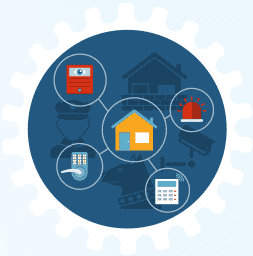Join our Community Alert Groups - whatsapp your Name, Surname & Address to 063 215 9554
Monday, December 16, 2019
Anxiety leads to Depression
Wednesday, November 27, 2019
Dissociative Identity Disorder
DID was called multiple personality disorder up until 1994, when the name was changed to reflect a better understanding of the condition—namely, that it is characterized by a fragmentation or splintering of identity, rather than by a proliferation or growth of separate personalities. The symptoms of DID cannot be explained away as the direct psychological effects of a substance or of a general medical condition.
DID reflects a failure to integrate various aspects of identity, memory, and consciousness into a single multidimensional self. Usually, a primary identity carries the individual's given name and is passive, dependent, guilty, and depressed. When in control, each personality state, or alter, may be experienced as if it has a distinct history, self-image and identity. The alters' characteristics—including name, reported age and gender, vocabulary, general knowledge, and predominant mood—contrast with those of the primary identity. Certain circumstances or stressors can cause a particular alter to emerge. The various identities may deny knowledge of one another, be critical of one another, or appear to be in open conflict.
In many parts of the world, possession states are a normal part of a cultural or spiritual practice. Possession-like identities often manifest as behaviors under the control of a spirit or other supernatural being. Possession states become a disorder only when they are unwanted, cause distress or impairment, and are not accepted as part of a cultural or religious practice.
Symptoms:
According to the DSM-5, the following criteria must be met for an individual to be diagnosed with dissociative identity disorder:
- The individual experiences two or more distinct identities or personality states (each with its own enduring pattern of perceiving, relating to, and thinking about the environment and self). Some cultures describe this as an experience of possession.
- The disruption in identity involves a change in sense of self, sense of agency, and changes in behavior, consciousness, memory, perception, cognition, and motor function.
- Frequent gaps are found in the individual’s memories of personal history, including people, places, and events, for both the distant and recent past. These recurrent gaps are not consistent with ordinary forgetting.
- The symptoms cause clinically significant distress or impairment in social, occupational, or other important areas of functioning.
Particular identities may emerge in specific circumstances. Transitions from one identity to another are often triggered by psychosocial stress. In the possession-form of dissociative identity disorder, alternate identities are visibly obvious to people around the individual. In non-possession-form cases, most individuals do not overtly display their change in identity for long periods of time.
People with DID may describe feeling that they have suddenly become depersonalized observers of their own speech and actions. They might report hearing voices (a child's voice or the voice of a spiritual power), and in some cases, the voices accompany multiple streams of thought that the individual has no control over. The individual might also experience sudden impulses or strong emotions that they don't feel control or a sense of ownership over. People may also report that their bodies suddenly feel different (like that of a small child or someone huge and muscular) or that they experience a sudden change in attitudes or personal preferences before shifting back.
Sometimes people with DID experience dissociative fugue in which they discover, for example, that they have traveled, but have no recollection of the experience. They vary in their awareness of their amnesia, and it is common for people with DID to minimize their amnestic symptoms, even when the lapses in memory are obvious and distressing to others.
Causes:
Why some people develop DID is not entirely understood, but they frequently report having experienced severe physical and sexual abuse during childhood.
The disorder may first manifest at any age. Individuals with DID may have post-traumatic symptoms (nightmares, flashbacks, or startle responses) or post-traumatic stress disorder. Several studies suggest that DID is more common among close biological relatives of persons who also have the disorder than in the general population.
Once a rarely reported disorder, the diagnosis has grown more common—and controversial. Some experts contend that because DID patients are highly suggestible, their symptoms are at least partly iatrogenic—that is, prompted by their therapists' probing. Brain imaging studies, however, have corroborated identity transitions.
Treatment:
The primary treatment for DID is long-term psychotherapy with the goal of deconstructing the different personalities and integrating them into one. Other treatments include cognitive and creative therapies. Although there are no medications that specifically treat this disorder, antidepressants, anti-anxiety drugs, or tranquilizers may be prescribed to help control the psychological symptoms associated with it. With proper treatment, many people who are impaired by DID experience improvement in their ability to function in their work and personal lives.
Saturday, November 23, 2019
Life thoughts to improve Positivity and Balance
Sunday, November 17, 2019
Introducing Our Youth to the Big World
The Happiest People Are Those Who Realized That God Is Enough
The Happiest People Are Those Who Realized That God Is Enough
I envy these people.
I want their faith.
I want their strength.
I want their solid feet when their world is falling apart.
I want their forgiveness when their heart is breaking.
I want their pace in moving on when something isn’t meant to be.
I want their ease in letting go of what they can’t control.
I want their peace of mind, knowing that God is enough, knowing that God is writing their story, knowing that God has better things planned for them and knowing that loving God is the only love they really need in their lives.
They’re not concerned with worldly pleasures, with things that are temporary or people who decide not to love them anymore. They have learned that as long as you depend on people for your happiness, they’ll always disappoint you but as long as you depend on God, you’ll always be reassured, you’ll always be satisfied and you’ll always wake up every morning thankful for life, grateful for everything in it, even your hardships.
People find happiness when they find God.
People understand life, when they understand God.
People truly start living when they make God their guide, their leader and their voice.
I don’t know how they got there but I know that this is the ultimate truth, this is how you enjoy your life and this is how you stay calm, strong and patient in times of pain and distress. This is how you heal.
Because once you learn that God is enough, you’ll never have to question yourself, you’ll never have to doubt yourself or your decisions. You become whole again. You become complete.
Maybe we’re all confused, hurt and sad because we still don’t know how to talk to God. We still don’t get it. We still ask for things that are wrong for us. We still hope to change our destiny. We still think he’s being too hard on us. We still think he doesn’t know what makes us happy.
Maybe we all can’t trust each other because we still don’t know how to trust God.
The happiest people are those who trust God blindly, because that’s how they see the light. That’s how they walk through life steadily no matter how bumpy the road may be, because they know that they’re being looked out for. They know they’re being protected. They know they’re being loved by God and that’s enough. More than enough.
Thursday, November 14, 2019
Hugging is the most beautiful form of communication
Hugging is the most beautiful form of communication
Hugging is one of the most amazing things that we could ever give another person. Hugging is essentially a form of therapy in itself.
When we receive hugs, it gives us a sense of comfort, care, love, understanding, and many other indescribable feelings. Having that said, wouldn't you agree that giving each other a hug every single day would be a good idea?
There is more to hugging than the surface appearance of it all. There is an actual science that happens within us when we are receiving a hug or giving one to someone else.
The physiological changes we experience deep within as we are being hugged could be described as one of the ultimate forms of being human and alive.
1. Balances the Nervous System

Tiny egg-shaped pressure sensors referred to as Pacnician corpuscles found within the skin are linked to the brain through our Vagus nerve.
Essentially what this means is that they sense the feeling of being touched.
What happens when moisture and electricity hover over the skin during a hug can show a balanced state of your nervous system parasympathetic, something that is achieved by psycho-physiological coherence that is created when you are passionately hugging someone!
2. Reduces Stress Levels
What happens is that when being hugged, the level of cortisol that is circulating throughout our body is reduced tremendously.
This means that our minds are able to calm down and think without stress. The next time you are with your significant other, give them the biggest hug you can summon!
3. Better Overall Mood
Something to keep in mind when thinking about depression or those who are lonely, is that they are experiencing really low levels of serotonin.
When you hug someone, the brain begins to release more serotonin and endorphin into your blood vessels, creating pleasure and expelling sorrow.
4. Relaxes Your Body
5. Heart Health Improves/Decreased Heart Rate
A study brought to light by the University of North Carolina - Chapel Hill, suggested that the volunteers who had little to no contact at all with their partners had developed a much faster heart rate of 10 beats per minute, compared to the standard 5 beats per minute of those who were hugged by their partner all the time.
Essentially, the lower your heart rate is the less trouble you will have for cardiac illnesses.
In short, we need to be hugging each other every single day for our mental and physical health. More importantly, our happiness.
Do you want to stress less, sleep better, and feel abundantly happier... without drugs or anything crazy?
God, Give me Strength to Fight Through it All
Lately, I’ve been feeling like I’ve been running in circles to no avail. Nothing seems normal anymore and my energy levels are running on fumes. Every night when I go to bed, I cry myself to sleep. I wonder when will the suffering finally come to an end. For each battle I win, there’s another fight around the corner. Sometimes, it seems there’s nothing else left to do but give up.
When I speak to my friends or family, they say “Have faith in God – he’ll show you the way”. God seems to have a lot of faith in me instead, testing me every day. But, I’m tired of fighting. I’m not sure how much more I can take. I understand that you have a plan for all of us, yet I sometimes wonder if I can go on. I’m not asking you to make it easy for me. Pain makes us stronger – I truly know that. I’m just asking you to give me strength so I can go on and finish my battles. The harder they are, the sweeter the victory.
The things happening around me have made me lose my course. I’m helpless and in crisis. I need a helping hand, God. Please hear my prayer and give me the strength I need. I need your help especially on the days when I can’t go on. I know you will hear me out. I know you’re not going to leave me alone. Things are hard right now, but I have faith in you. I come to you for strength and nothing else. Give me the strength to endure the hard trials and the energy to go on.
Give me strength, God, so I can live to see another day. That’s all I’m asking.
XOXO
Saturday, November 9, 2019
Considerations for securing your home
Considerations for Securing Your Home
Home Security topics are important to address because burglaries happen on a regular basis due to neglect from homeowners and renters. To prevent break-ins, people have to become familiar with ways on protecting their homes and be aware of the tips on how to deal and report a crime to the police if they get in such a situation.
We will cover different tips on preventing property crime. By controlling access, providing visibility, & maintaining your property, you are not only protecting your belongings and home, but also yourself and your family.
Unfortunately, burglaries are not the only things that pose danger to a home. Properties are also subject to fires. More often than not, they are caused by cooking or plain neglect and lack of responsibility.
Taking active measures to keep your home safe from fires is important, as is having emergency contact(s) available in the event something unfortunate occurs.
This guide is designed to provide you with knowledge and tips on how you can enhance the security of your home and property. Please comment your thoughts in the comments section at the end of this post. We would love to hear from you!
First lets start understanding the mind of a Burglar....
Let's a take a look at how these thieves minds work...
Time, sound, and visibility are the three main factors that need to be considered when trying to prevent theft from a home. Some questions you might want to ask yourself include:
- Are my doors locked (and double locked if posssible) at the main entrance?
- Are my other doors locked from access?
- Are my windows shut all the way?
- Is my property well-lit at night?
- Can I see any of my valuables from outside on the street?
- Are there areas in my neighborhood that could offer cover or leverage for a criminal to break in easily?
- Does my routine at home make it easy for a thief to know when is the best time to try and enter?
What are some things I can do by myself to prevent burglaries?
Thieves are always looking out for themselves, so it is crucial to do the same and be ruthless in protecting your own home, self, and family from any dangerous or unwanted situation. By staying aware and actively playing on the safe side, you will shoo off the bad guys. Here are some measures you can take to prevent burglaries.

Get a dog.
Dogs will often bark when they sense unfamiliar people coming to your doorstep, warding off potential criminals.

Be smart about who you let into your home.
Sometimes, even your gardener or maid might have ulterior motives and can't be trussted. With that said, it's crucial to keep a close eye on people you hire to work in your home, and keep your valuables secured somewhere out of reach. Keep in mind that anytime you let someone into your home, you are essentially giving them an opportunity to steal, scope out your valuables, and/or make plans to come back at another time to take your belongings that they've been eyeing.

Always complete a background check & ask for references on new contractors.
After workers leave, be sure to go through your valuables and make sure everything is still there.

Install a home security/alarm system.
A home security camera will be a great thing to have because it will essentially keep tabs on people, and help you keep an eye on unwanted visitors and behavior. If getting a dog is not practicle for you, then installing an alarm system is a must.

Get to know your neighbors.
A great way to ward off unwanted visitors and potential burglars is to get friendly with your neighbors so that everyone can help each other out. This is especially helpful when/if you go on vacation for an extended period of time and need someone to help you keep a closer eye. Burglars are a lot less likely to go through with their criminal activity if they think they might be watched.

Make sure your doors and windows are locked.
This step is the easiest way to keep burglarsand unwanted visitors out of your home. Easy access will invite bad news and people.

Don't accept unsolicited help.
Unless you call someone to come over and perform a service, don't let them in. Many thieves are con artists who put on a front, making themselves look like a plumber, painter, tree trimmer, etc. They will often come with one other person. One may lure you outside to talk about the service they are "offering", while the other may run into your house to go through your belongings while you are kept distracted and busy.

Install lights outside your doorstep area so that your home is well-lit at night.
Thieves will frequent dark areas because it's harder for them to run away and not get caught if there is plenty of light. With that said, having light around your home at night will keep your area well-lit and more likely clear of criminals.

Be careful with what you throw in the trash.
Some criminals will go through your trash to see what you've left behind. For example, if you recently bought an expensive TV and are throwing out the packaging, a criminal who sees that might use that as a clue and incentive to come back and find a way to get the TV. If you're trying to get rid of trash from any significant purchases, make sure to cut up the packaging and make it as inconspicuous as possible.

Keep your home well-kept.
By trimming your bushes and eliminating potential "hiding spots", thieves are a lot less likely to show up and try to steal from your home. Keeping your place well-kept also signifies that the home is lived in and that you're not away on vacation for an extended period of time.
Identifying & Maintaining Your Home
In addition to being aware of the general tips to keeping your home safe from criminal activity, it is also important to be able to identify and maintain your home. To do this, you will want to:
Write your driver's license number somewhere on any valuables that might be stolen so that they can be identified.
Take detailed pictures of items that you can't write on.
Make sure that you keep an updated record of your valuables. This record might include model, type, serial number, fair market value, and proof of purchase, to name a few.
Replace broken windows, locks, and doors when needed.
Fix broken fences and locks when needed.
Keep loose rocks away from the property to avoid vandalism and break-ins.
Keep your home in good condition: mow the lawn, rake the leaves, clean the litter, etc. to indicate that your home is lived in and not being neglected.
Make sure that your street address number is clearly visible from the street so that cops can find your home easily as needed.
How Can I Keep My Home Safe While on Vacation?
Before going on vacation, it is important that everything in your home is in working condition. This includes your locks, security cameras, alarms, and doors. Prior to leaving, you should also do the following to ensure that you have a relaxing vacation and come back to a safe home. It is also a good idea to have some home security systems or even a doorbel camera so you can keep an eye on things while you are away.
What Do I Do In the Event I Get Robbed?
Have a list and photos of your valuables on hand and ready to report. If you come home and the door is unlocked or open, and things look like they're out of place, leave everything as is and call the police right away. Never confront a burglar to stay on the safe side, but if you spot him/her, be sure to take a good look at what they're wearing, what they look like, and what they have taken out of the house. It is also highly recommended to monitor your identity if someone has had access to your personal information.
Home Security Technology
Keeping your home safe is a lot easier now than before thanks to advanced technology. For example, remote monitoring cameras allow you to view activity in the home from work, vacation, or virtually anywhere outside of the home, on your phone. Even if you are miles away from home, you can still see in real-time what is going on in your home. Many security systems nowadays also allow you to arm and disarm them remotely. This means that even if you forget to arm the house before you left, you can still do so from your phone. In addition to remote monitoring, smart locks also exist to automatically lock doors once they sense that you have left the home, using bluetooth on your phone. Home sensors are great for detecting motion. When armed, motion triggers will be sent to your mobile device. This way, you will be immediately notified if someone is trying to break into your house. Of course, the types of technology are endless, but these are a few common ones found in many homes today.
Creating a Home Fire Defense Plan
In addition to warding off burglars from your home, it's also important that you have a home fire defense plan so that you and your family stay safe from any fires that might take place in the home. Some simple but essential steps to take include:
Conclusion
There are so many different ways to ensure home security. Some are common sense, everyday practices that we already do, while other techniques require more planning and awareness. Either way, this guide is designed to educate homeowners to take extra precautions to protect their homes. By being aware of all the different types of home security technologies out there and knowing how to create a home fire defense plan, for example, one will be ahead of the game in terms of protecting him or herself from potential danger -- whether it be as a result of a burglar or a house fire. Taking measures for home security may feel like a lot of work and may cost you a bit initially, but is well worth it to ensure safety and to prevent unnecessary stress later down the line. After all, a safe home is a happy home!
Thursday, November 7, 2019
I spend a lot of my time now reminding myself "I AM THE ADULT. I AM THE ADULT...."
Brainfog... a harsh reality that makes sense to slow down!
Not feeling yourself lately? ...forgetting things? You think you going crazy now too? Gosh did i feel like this... and i can say reading this article now, i am convinced that about 90% of people today feel this way. So take a quick read through, adjust your lifestyle, and pick yourself up again... 'cos life aint waiting for you!
Brain fog can be particularly concerning for usually sharp-minded individuals, who suddenly find their days disrupted by confusion and memory loss. Is it reversible?
What makes understanding this ailment more complex is that brain fog isn’t technically a medical condition at all, but rather a symptom of other conditions. It can last anything from minutes to years, making people feel disorientated,
confused and generally mentally slower than they’re used to.
If you’ve ever had a spate of entering rooms and forgetting why, going blank on the directions to a place you regularly drive to, or being uncharacteristically unable to focus, you may be experiencing this unpleasant symptom. Brain fog can be quite alarming, often leaving sufferers wondering whether they’re developing dementia or some other cognitive disorder, which isn’t necessarily the case.
It usually manifests as:
- Confusion and disorientation.
- Difficulties with spatial awareness and information processing.
- The awareness that your faculties of thought, understanding and memory aren’t functioning properly.
Why does it happen?
There are a number of potential causes, which is why identifying the underlying issue is essential to tackling the problem. In most cases, treatment of the root problem will relieve or reverse brain fog. Common causes include:
Chronic stress
Stress has various physical effects on the body, including headaches, digestive issues, heightened blood pressure and a weakened immune system. It can also be mentally exhausting. This makes it more difficult to reason, focus and understand. Take stock of events in your life that may be raising your stress levels, incorporate stress-reducing activities like meditation and yoga, and allow yourself time to rest. Remember, too, that the more anxious you
become about your brain fog, the more you exacerbate it: like all other forms of panic, the key is to relax and trust that
this, too, will pass.
Incorrect eating
Everyone reacts differently to different foods. Eating correctly means eating what’s right for your body’s specific needs. Foods that induce brain fog in some people include dairy, aspartame, peanuts and MSG, as well as a deficiency in vitamin B-12. Keep track of what you eat and how you feel following each meal, or keep a food journal to help you identify potentially triggering foods.
Certain medications
Brain fog might be a known side-effect of a medication you’re taking, so tell your doctor how you’re feeling. You may be able to lower your dosage or switch to an alternative medication.
Illness and medical conditions
Various medical conditions can cause brain fog, especially those associated with fatigue, changes in blood pressure
and inflammation, such as fibromyalgia. Others include diabetes, hypothyroidism, migraines, anaemia, depression and autoimmune diseases. Your doctor may order tests to determine whether you’re suffering from a condition that’s causing it. You might then be put on treatment like iron supplements for anaemia, or an anti-inflammatory for an autoimmune condition. As the condition’s managed, the brain fog will recede.
Lifestyle changes for a clearer mind
Besides seeking medical treatment, there are various changes you can make to tackle brain fog. These adjustments may be the key to sharpening your mind:
- Ensure you’re getting enough good-quality sleep – at least eight hours a night.
- Avoid a sedentary lifestyle and exercise at least three times a week.
- Overhaul your diet and include healthy ‘brain foods’, such as those rich in omega-3 and vitamin B-12.
- Cut down on alcohol and caffeine.
Do you have an article that will UPLIFT the Community? Mail us! Crimebustersrsa@gmail.com
FEATURE: CAITLIN GENG PHOTO: STOCK.ADOBE.COM
Thank you to YourFamily.Com for this article!
Monday, November 4, 2019
Know a Shoplifter when you see one!
Padding items: This method involves stuffing extra items into boxes or bags of items they intend to purchase. If the items are found by the cashier, the shoplifter generally claims that they didn’t know the items were in there, and refuse to pay for them.
Using their children: Some parents will use their children to get away with a crime. Parents may use their infant’s stroller to conceal items. Merchandise can be easily tucked around or under the infant and covered with a blanket, or hidden in diaper bags or the folds of a folding canopy. Parents can also use small children to carry items out of a store, either by handing the merchandise to the child, or even directing the child to take the item and conceal it. If they are caught, the parent will scold the child, and claim that they had no idea that this was happening.
Hiding items: Merchandise can be hidden up the sleeve, in boots or socks, and even in underwear. Watch for customers that constantly fidget with their cuffs, and pull their hands all the way up in their sleeves, bend down to tie their shoe laces more than once, something isn’t right. Customers with usually bulky or out-of-season clothing should also be watched. Some shoplifters also use a jacket draped over one shoulder to conceal their actions, and hide items in the sleeves.
Wearing it out: This is a favoured technique for clothing and shoes. Often the shoplifter will wear the item around the store for several minutes, before simply walking out with it. Usually they will first remove the price tags, and tuck them out of sight.
Hiding in plain sight: This is a favoured technique for large or heavy items. By holding an old receipt in one hand, the shoplifter will walk out of the store as if the item has already been paid for. Another variation of this method is when the shoplifter brings empty bags usually hidden in a pocket, or full bags and packages into the store and when they feel they are not being watched, they will start filling them with merchandise. If they are stopped they will say that these items were bought from a different store. A variant of this method is to simply pick an (usually) expensive item and to simply walk out. This method is favoured by professionals, because they are usually in and out of the store with their item in less than one minute, without anyone noticing.
Grab and Run: Similar to the previous 2 methods, but this one involves very little skill, and is usually done with an accomplice who waits in a running car. The shoplifter will walk into the store, grab what they can carry, and run out again. These are the most dangerous types of theft, because they are usually carried out by desperate people, such as drug addicts.
Groups of children or teenagers: Watch groups of children or teenagers especially carefully, because peer pressure can be a strong influence on normally law-abiding youths. Sometimes groups will loiter in front of a store, looking for the security measures and how attentive the staff is.
Here are some things you can do to prevent shoplifting:
- Make sure that your employees are trained at spotting and apprehending shoplifters.
- Keep your store and the display shelves neat and organized, so that your employees can observe the customers and see if something has gone missing.
- Eliminate blind spots by placing mirrors in the corners, and consider using electronic article surveillance systems or cameras to monitor your store and merchandise.
- Prevent grab-and-runs by keeping merchandise away from the exits, and design your layout so that all people entering and exiting the store must pass by security personnel or employees.
- Keep expensive items in locked cases, and limit the number of items that employees remove at any one time for a customer, and ensure that they are replaced when the customer is finished.
- Fitting rooms and restrooms should be watched at all times, and limit the number of items taken into a fitting room and don’t allow unpaid merchandise to be taken into the restrooms.
- Keep the cash register inaccessible to customers and monitored at all times.
Crime Prevention for Businesses
CRIME PREVENTION & SAFETY FOR BUSINESSES – ROBBERY & SHOPLIFTING
Here is a series of posts to help you create a safe environment for your business, staff and assets.
ROBBERY
If someone threatens you with a weapon and demands money, give it to them – never refuse a robber!
Below are a few tips on how to prevent robbery:
- Do not work alone. If you are alone, turn on a TV or radio in a back room so that potential robbers think that someone is with you.
- Do not make bank deposits at the same time every day, rather vary them, so that no one can predict your schedule. Keep minimal cash in the drawer, so that if you are robbed, your loss is minimized.
- Arrange your store so that the cash register is visible to passers by, and a potential robber would be seen from the street. Do not block the windows with posters that could block visibility from the street.
- Put up clear signs that the safe requires a secondary key that is not on the premises.
- If you do not have one, install a security alarm, and consider getting one with a panic button. Advertise that you have an alarm with clearly visible stickers. Make sure that your employees know how and when to use the panic button.
- Talk to other stores in your area. Agree on keeping an eye on each other’s stores or buildings and to watch any suspicious activity.
- Paint or stick a series of markings by the door at 1 foot increments so that it is easier to estimate a robber’s height as he leaves.
- Record the serial number of the bottom bill in each drawer and instruct employees not use these bills.
- Consider keeping “bait money” in a compartment of the cash register. The bills should be separated by face value and serial numbers recorded, so that they can be given to law enforcement officers if you are robbed.
If you are being robbed:
- The most important rule if someone is threatening you with a weapon is to comply with their demands.
- If you have a silent alarm and can activate it without being noticed, do so, otherwise wait until the robber has left.
- Try to signal other employees with a pre-arranged signal, but avoid any sudden moves.
- Try to get a good look at the suspect, so you can give a description to police officers.
After a robbery
- Call 112 immediately from your cell
- Immediately after calling the police, write down everything you can remember about the incident, and description of the robber, including:
- Height
- Weight
- Colour of hair and eys
- Race
- Identifying features such as scars, tattoos, accent or anything unusual
- Clothing
- Weapon
- Mannerisms
- Try to get a look at the escape vehicle and license plate numbers and the direction of travel.
- Keep everyone away from surfaces or objects the robber may have touched.
SHOPLIFTING
A shoplifter is a person who steals goods from a store while pretending to be a customer. Shoplifting can be done in one of two ways:
- By concealing an item and walking out of the store
- By keeping an item in plain view and walking out of the store.
In either case, it means a financial loss to the businesses they target.
There are several types of behaviours that shoplifters will exhibit, and a variety of techniques they will use to carry out their crime.
When honest customers shop, they will generally look at items, check the price and size, in an attempt to decide if they want, need or can afford the item. Shoplifters don’t generally exhibit this type of behaviour, instead of looking at the merchandise, they will look around for the store cameras and employees, in an attempt to avoid them. Some shoplifters will wear sunglasses inside the store to disguise the fact that they are not looking at items. If a shoplifter is offered service by an employee, they will generally give a vague answer like “just looking, thanks” in the hope that the employee will leave them alone to go about their business.
Do you have anything to add? Comment below!
What causes Robbery?
Sunday, November 3, 2019
Questions you should think about daily...
Anxiety leads to Depression
Anxiety makes you feel like a burden. You don’t want to text your friends, even though you’re dying to hang out with them, because you’re wo...

-
We are here to help your child empower themselves to grow positively and effectively going into adult life by introducing our youth to local...











































